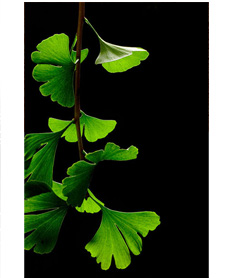







Gingko biloba leaves
Gingko (Gingko bilobais), also spelled ginkgo, and known as the Maidenhair Tree, is a unique species of tree with no close living relatives. The tree is widely cultivated and introduced, since an early period in human history, and has various uses as a food and traditional medicine.
Extracts from the leaves of the gingko tree have shown potent free radical scavenger activity when applied to the skin.
Ginkgo flavone glycosides, mostly quercetin and kaempferol derivatives, can inhibit tyrosinase activity by chelating copper in the enzyme.
In a study conducted by the Department of Dermatology, Postgraduate Institute of Medical Education and Research in Chandigarh, India it was shown that Ginkgo is an effective treatment for arresting the development of vitiligo. In the study 25 participants took 40 mg of Ginkgo biloba three times per day for 6 months. The results showed that it arrested the spread of vitiligo in 20 out of 25 participants in the active group, and induced marked (75% or greater) repigmentation in 10 of these participants.
A later study conducted by University of Toronto researchers and published in 2011 consisting of twelve patients taking 60 mg of Ginkgo biloba twice a day for 12 weeks found that the progression of vitiligo stopped in all participants; the total VASI (Vitiligo Area Scoring Index) indicated an average repigmentation of vitiligo lesions of 15%.
>
>
>
>
>
>
>
>
>
>
>
>
>
>
>
>
>
>
>
>
>
>
>
>
>
>
>
>
>
>
>
>
>
>
>
>
>
>
>
>
>
>
>
>
>
>
>
>
>
>
>
TOP 20
Hydroquinone
Monobenzyl Ether of Hydroquinone
Azelaic Acid
Kojic Acid
Arbutin
Retinoids
Mequinol
Niacinamide
Soy
Vitamin C
Corticosteroids
Licorice
Hydroxystilbene
Aloesin
Glutathione
Glycolic Acid
N Acetyl Glucosamine
Gentisic Acid
Green Tea
Melatonin
SKIN WHITENING AGENTS A-Z
a-Hydroxyacids
Aloesin
Alpha Tocopherol and Alpha Tocopherol Ferulate
Arbutin
Azelaic Acid
Centaureidin and Methylophiopogonanone B
Gallic Acid and Derivatives
Gingko
Ginseng
Glutathione
Glycolic Acid
Green Tea
Hesperidin
Hydroquinone
Hydroxycinnamic Acid and Derivatives
Hydroxystilbene
Kojic Acid
Licorice
Linoleic Acid
Magnesium Ascorbyl Phosphate
Melatonin
Mequinol
Monobenzyl Ether of Hydroquinone
Mulberry
N Acetyl Glucosamine
N-Acetyl-4-S-Cysteminylphenol
Niacinamide
Retinoids
Salicylic Acid
Soy
Vitamin C

<< Previous: Gallic Acid and Derivatives
Next: Ginseng >>